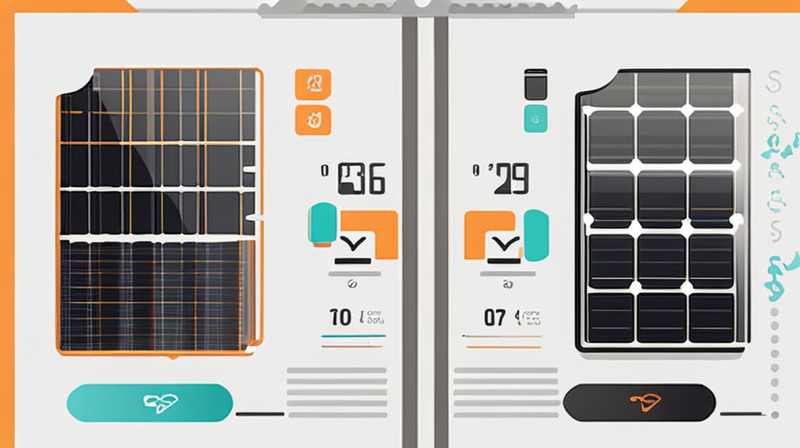
To accurately determine the energy output from photovoltaic systems, key calculations must be undertaken. 1. Understand the efficiency of the solar panels, 2. Evaluate the sunlight exposure duration, 3. Factor in the area of the solar array, 4. Assess local environmental conditions.
1. UNDERSTANDING SOLAR PANEL EFFICIENCY
The effectiveness of solar panels is primarily measured by their efficiency, which indicates how well they convert sunlight into electricity. Most commercially available solar panels have an efficiency range of 15% to 22%. This percentage represents the ratio of the energy output to the energy input from sunlight. For instance, if a solar panel is rated at 20% efficiency, it means that it can convert 20% of the sunlight that strikes its surface into usable electric power.
To compute the total potential energy generation, one must first ascertain the panel’s wattage. This is usually specified on the panel’s label and indicates how much electricity will be produced in optimal conditions. If a panel is rated to produce 300 watts under standard test conditions, it will generate that amount when exposed to peak sunlight for an hour. Therefore, efficiency plays a crucial role in understanding how much energy can be harnessed from a given solar setup.
2. EVALUATING SUNLIGHT EXPOSURE DURATION
The next aspect to consider is the average duration of sunlight exposure, commonly referred to as “peak sun hours” (PSH). This measurement indicates how many hours per day the solar panels receive sunlight at an intensity of 1000 watts per square meter. Regions with more sunny days will have higher PSH, making them more favorable for solar energy production.
For example, if an area receives an average of 5 peak sun hours daily, this means the solar system can operate at its rated capacity for that duration. A solar panel array rated at 300 watts, receiving 5 hours of peak sunlight, would generate approximately 1500 watt-hours of electricity in one day. This variable plays a significant role in expected energy output and must be factored into calculations upfront.
3. FACTORING IN ARRAY AREA
The area covered by the solar panels also significantly influences energy production. Calculating the total square footage of solar panels ensures the collector’s dimensions align with energy goals. Larger installations typically yield more power, assuming all other variables are constant.
For example, if a solar panel measures 1.6 square meters and produces 300 watts, multiple such panels could be installed to achieve higher outputs. The cumulative capacity “N” panels would generate can be quantified as (N \times 300 \text{ watts}). If planning a solar array, understanding the space available and potential output is vital for appropriate design and installation.
4. ASSESSING LOCAL ENVIRONMENTAL CONDITIONS
Local environmental factors play an essential role in solar energy generation. Elements such as shading, dirt accumulation, and atmospheric conditions can hinder the performance of solar panels, leading to decreased energy output. For accurate calculations, it is crucial to assess these variables as they might affect the overall efficiency of the solar system.
When panels are shaded by trees, buildings, or clouds, the amount of sunlight they can effectively capture diminishes. Furthermore, dust and dirt on the surface of solar panels can significantly reduce their operational efficiency if not cleaned regularly. Evaluating the geographic location and ensuring optimal placement can mitigate these concerns and maximize solar energy collection.
FAQs
WHAT IS THE FORMULA FOR CALCULATING SOLAR ENERGY PRODUCTION?
To determine the potential energy production from a solar panel system, the following formula can be used: [ \text{Energy} = \text{Panel Wattage} \times \text{Peak Sun Hours} \times \text{Panel Efficiency} \times \text{Number of Panels} ] For example, a single 300-watt panel with an efficiency of 20% installed in a location receiving an average of 5 peak sun hours per day would yield approximately (300 \text{ watts} \times 5 \text{ hours} = 1500 \text{ watt-hours/day}). Adjustments must be made for environmental conditions that may influence the actual output.
HOW MUCH ROOF SPACE DO I NEED FOR SOLAR PANELS?
The amount of roof space needed for solar panels will vary depending on the system size desired and the efficiency of the panels selected. For instance, if one aims to install a 5 kW system using 300-watt panels, approximately 17 panels would be needed. Assuming each panel occupies around 16 square feet, the total space required would be about 272 square feet. Therefore, it is crucial to consider both the panel size and the energy requirements when evaluating roof space.
WHAT FACTORS AFFECT SOLAR PANEL PERFORMANCE?
Several factors can impact solar panel performance. Temperature, orientation, tilt angle, and shading are critical aspects. Panels tend to operate less efficiently at high temperatures; therefore, ensuring proper ventilation can bolster efficacy. Moreover, optimizing the orientation (usually south-facing in the northern hemisphere) and tilt angle for local latitude helps maximize sunlight capture. Shading from nearby structures or trees can also substantially hinder performance; thus, it’s essential to choose installation locations wisely.
Bold assertion: Understanding the intricacies involved in calculating solar energy production is imperative for anyone interested in harnessing solar power effectively. A comprehensive grasp of efficiencies, sunlight exposure, area calculations, and environmental conditions can empower individuals and businesses alike. All of these factors synergize to determine the power output and feasibility of solar installations. With renewable energy becoming increasingly vital for sustainable futures, mastering these calculations not only enhances the effectiveness of solar systems but also contributes to responsible energy consumption and environmental stewardship. Therefore, engaging in extensive research on solar technologies and fostering professional relationships with installation experts can yield fruitful ventures into the realm of solar power. Investing time in calculations and understanding the scientific underpinnings will enable informed decisions, empowering consumers to select optimal systems aligned with specific energy needs and financial goals. Adopt a meticulous approach, and reap the longevity and benefits of solar energy in a world increasingly reliant on sustainable practices.
Original article by NenPower, If reposted, please credit the source: https://nenpower.com/blog/how-to-calculate-the-power-of-solar-energy/


